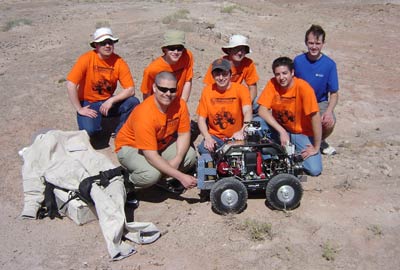University students prove they are up to the challengeby Kevin Sloan and Alex Kirk
|
| A tele-operated rover like those built for the URC would enable astronauts remaining in the habitat to conduct meaningful field work while fulfilling their HabCom duties, such as advanced reconnaissance or routine facility maintenance. |
Perhaps the most sinister of challenges was the Construction Task, which required teams to secure a series of panels by tightening standard nuts and bolts. The target fasteners were placed between 15 and 75 centimeters above the ground and could be tilted forward or backward up to 45 degrees, making this difficult task even more overwhelming. In what ended up being the most dramatic and exciting event of the competition, the Emergency Navigation Task gave teams 35 minutes to deliver a small box of supplies to a distressed astronaut in the field, provided only with his last known coordinates.
The competition
Battling high winds on the first day of competition that destroyed several logistics tents, and hindered teams’ abilities to erect antenna masts, rovers were put to work in the Construction and Geology Tasks. In the former task, the awkwardly inclined bolt panels proved to be exceptionally difficult for most teams, most of whom were unable to properly secure the panels. York University took a narrow victory in this event by being the only team to fully secure a single bolt. The tents weren’t the only casualties of the first day, as UCLA suffered a last-minute mechanical problem that could not be corrected in the field, and was forced to withdraw from the competition.
Day two and its calmer weather put teams to work in the Emergency Navigation and Soil Characterization Tasks. In the former event, Oregon State built a large lead by being the only team to successfully locate the distressed astronaut in the alloted 35 minutes. Georgia Tech and Iowa State University finished second and third in that event, turning in rousing performances that brought them within a few meters of the astronaut as the clock ticked down to zero.
Georgia Tech began their 35-minute time period without the ability to communicate with their rover, due to an as-yet-undiagnosed wireless communications problem. Scrambling to get their rover moving with just five minutes left, it appeared as if they would never leave the start line. In a sudden stroke of outside-the-box genius, the team suddenly realized that, since they could score points for being within a certain distance of the astronaut as time expired, they stood a reasonable chance simply by hard-wiring their motors to the batteries and letting the rover drive on its own, completely uncontrolled. They raced over, made the switchover, and sent the rover on its way. Navigating over several hills and gullies, the rover at first appeared to be headed off-course, when it hit a hill and changed direction -- heading directly for the astronaut. After another pair of unintentional course corrections, the rover ended up within 10 meters of the astronaut as time expired, leaving Georgia Tech with the second-highest score of the day for the challenge.
Brigham Young University, which was unable to compete in the first two events due to problems booting their rover’s operating system, fixed those problems overnight and brought their rover to the Soil Characterization Task, where they impressed the judges.
“Their science payload was particularly amazing because of the way they used common household products,” said judge Heather Smith. “They had an electric toothbrush to clean off rocks, a standard mechanical drill, and a common thermometer. It’s just a shame that their drive train failed before they could finish the event.”
The Challenge was particularly successful from a skill-building and educational point of view, as pointed out by Alan Spencer, guest judge from URC sponsor Raytheon.
| “We’ll definitely be back next year, that’s 100 percent,” said York University student Chanpreet Amole. “Next year we’ll have a bigger team and a better rover.” |
“I was really impressed by the professionalism of all of the teams,” he said. “These students are going to make really excellent engineers and scientists as they enter the workforce, and I think that they’ll all be in better shape because of their participation this year.”
In the end, out of 400 total possible points, only 30 points separated Oregon State in first place and the University of Nevada, Reno in second place. York University, in third place, led a pack of teams in pursuit of the leaders, and echoed everyone’s excitement to return for next year’s event.
“We’ll definitely be back next year, that’s 100 percent,” said York University student Chanpreet Amole. “This has been so much fun, and we’ve all learned so much. Next year we’ll have a bigger team and a better rover.”
In addition to a cash prize, Oregon State won free transportation and lodging for five of its team members to the 11th Annual International Mars Society Convention, to be held August 14–17, 2008 in Boulder, Colorado. There they will have the opportunity to show off their work and present to a packed house as part of an exciting speaker lineup.
